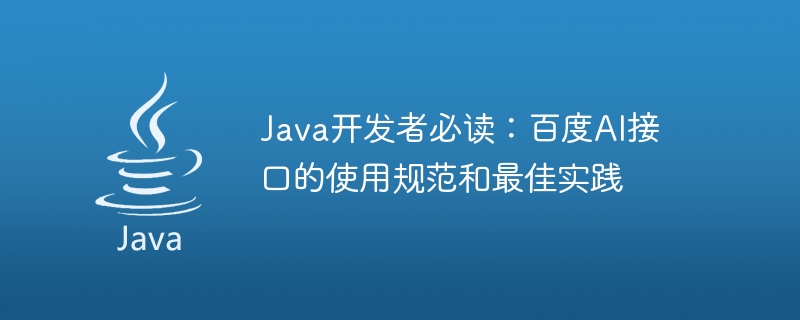

Must-read for Java developers: Baidu AI interface usage specifications and best practices
Introduction:
Artificial Intelligence (AI) technology Widespread applications are changing the way we live and work. As one of the world's leading Internet companies, Baidu AI platform provides a wealth of AI interfaces and tools to help developers quickly build intelligent applications. This article will introduce the usage specifications and best practices of Baidu AI interface, and provide Java code examples to help Java developers easily use Baidu AI interface.
1. Baidu AI Interface Specification
<dependency>
<groupId>com.baidu.aip</groupId>
<artifactId>java-sdk</artifactId>
<version>4.7.2</version>
</dependency>import com.baidu.aip.face.AipFace;
public class FaceRecognition {
private static final String APP_ID = "your_app_id";
private static final String API_KEY = "your_api_key";
private static final String SECRET_KEY = "your_secret_key";
public static void main(String[] args) {
AipFace client = new AipFace(APP_ID, API_KEY, SECRET_KEY);
}
}import com.baidu.aip.face.AipFace;
import org.json.JSONObject;
public class FaceRecognition {
// 省略初始化SDK的代码
public static void main(String[] args) {
AipFace client = new AipFace(APP_ID, API_KEY, SECRET_KEY);
// 人脸检测接口示例
String image = "your_image_path";
JSONObject detectResult = client.detect(image, new HashMap<String, String>());
// 人脸比对接口示例
String image1 = "your_image_path1";
String image2 = "your_image_path2";
JSONObject matchResult = client.match(new String[]{image1, image2}, new HashMap<String, String>());
}
}2. Best practices
import com.baidu.aip.face.AipFace;
import com.baidu.aip.face.FaceException;
import org.json.JSONObject;
public class FaceRecognition {
// 省略初始化SDK的代码
public static void main(String[] args) {
AipFace client = new AipFace(APP_ID, API_KEY, SECRET_KEY);
try {
String image = "your_image_path";
JSONObject detectResult = client.detect(image, new HashMap<String, String>());
String image1 = "your_image_path1";
String image2 = "your_image_path2";
JSONObject matchResult = client.match(new String[]{image1, image2}, new HashMap<String, String>());
} catch (FaceException e) {
// 处理异常情况
e.printStackTrace();
}
}
}import java.util.concurrent.ExecutorService;
import java.util.concurrent.Executors;
public class FaceRecognition {
// 省略初始化SDK的代码
public static void main(String[] args) {
AipFace client = new AipFace(APP_ID, API_KEY, SECRET_KEY);
ExecutorService executorService = Executors.newFixedThreadPool(10);
for (int i = 0; i < 100; i++) {
final int index = i;
executorService.submit(() -> {
String image = "your_image_path" + index;
JSONObject detectResult = client.detect(image, new HashMap<String, String>());
System.out.println(detectResult.toString());
});
}
executorService.shutdown();
}
}Summary:
This article introduces the usage specifications and best practices of Baidu AI interface, and provides Java code examples to help Java developers quickly Get started using Baidu AI interface. I hope this article can provide some help and guidance to Java developers when using Baidu AI interface, so as to achieve a better development experience and higher application quality.
The above is the detailed content of A must-read for Java developers: Baidu AI interface usage specifications and best practices. For more information, please follow other related articles on the PHP Chinese website!
 setInterval
setInterval
 What is the shortcut key for brush size?
What is the shortcut key for brush size?
 Detailed explanation of linux dd command
Detailed explanation of linux dd command
 How to solve disk parameter errors
How to solve disk parameter errors
 What are the SEO diagnostic methods?
What are the SEO diagnostic methods?
 What are the css3 gradient properties?
What are the css3 gradient properties?
 The most promising coin in 2024
The most promising coin in 2024
 What does pycharm mean when running in parallel?
What does pycharm mean when running in parallel?
 The difference between PD fast charging and general fast charging
The difference between PD fast charging and general fast charging




